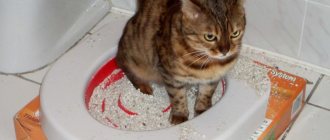Safety first
Before accustoming your cat to walking, it is important to take into account all controversial issues. Walking unattended is a great danger. Statistically, almost 80% of animals that walk unattended one day simply do not return home, that is, they die.
Self-walking is dangerous - this is a fact confirmed by dozens of arguments. A free-ranging animal is at risk of death due to:
- The ill will of people.
- Dog attacks.
- Poisoning.
- Falls from heights.
Cats often fall into traps, and increasingly, this happens due to the lack of forethought of the owners. Trying to be responsible, owners put collars with address tags on their pets. Cats often climb trees and enter various hiding places. It is important to understand that your pet can get caught in the collar and become trapped or die from suffocation.
Important! The most reliable way to keep your pet safe is to control its walks. Even after training your cat to go to the toilet outside, leave a tray in your home so that you can limit your pet from walking unattended.
How to accustom a kitten to the street?
Of course, training is easier if you are raising a kitten. All kids are naturally curious and fearless; they have no acquired complexes or negative life experiences. In addition, the kitten considers its owner to be its mother, or at least the main protector who can be trusted.
If you want your kitten to go outside to the toilet, you need to start by teaching him to go for walks. For safety reasons, the kitten should take its first walks in his arms, then in a harness and on a leash . Don't rush your pet, he needs time to get used to the big world.
If you live in a private house and you got a kitten in winter, you should wait until spring for walks. The first forays should be short. Carry the baby in your arms for 5–10 minutes, constantly stroke and soothe. The purring of a kitten in your arms can be considered a good sign - cats do not purr while they feel discomfort or danger.
After the first stage of adaptation to the street, you need to check how confident the kitten feels. Without placing your pet on the ground, offer him a treat. You can be sure that your baby will be calm if he eats in an unfamiliar environment. If your pet is excited, try to set an example for him - eat something yourself. Perhaps the kitten will be able to reassure itself that the area is safe if it recognizes your confidence.
The next stage is training to use a harness and leash. The first walks should be taken at home. Don't pull on the leash, just follow the kitten. When your pet gets used to the new accessory, move it outside for walks. The final feature is exploring your own territory. The kitten must clearly understand which area is safe for walking.
As soon as your pet begins to confidently go outside, you need to place the tray in a convenient place for you. Fill the tray with fresh litter and mix in the already used litter. This will give the new tray a familiar smell. When the kitten begins to confidently use the new tray, the substitute should be gradually replaced with soil.
After the ward gets used to digging, he will either start going to the toilet in the front garden himself, or:
- We take a street tray.
- We dig it in the front garden so that the sides barely peek out.
- Fill the tray to the top with soil.
- We praise the kitten for every relief of need on the street.
As your ward grows, if you do not want to put him in danger, you need to think about castration. Uncastrated males constantly fight and leave their own territory, females bring kittens. Neutered cats and female cats, based on the experience of their owners, stay closer to home and are more concerned about protecting the territory.
Tidbit or gingerbread method
Education is an entertaining process, especially when there is a return.
So, this same return can be obtained twice as fast if you use incentives for each successfully completed task. This could be a favorite treat: a piece of sausage, a piece of chocolate, the main thing is that the kitten really wants it at a specific period of time. By the way, you can always carry a tasty morsel with you, in the pocket of your robe or trousers, and start training with your pet at any time when there is an opportunity and the “student” is in a favorable mood.
As soon as the animal appears in the field of view, they beckon it to you with their fingers, while pronouncing the invented name out loud (by the way, all household members of the kitten should call it the same so that the poor thing does not get confused)
When the baby deigns to pay attention to the owner and comes up, he is treated to a “delicacy”, gently scratched behind the ear or patted on the back, continuing to click on the name
Over time, it will be enough to simply call the baby so that he runs up to his beloved owner. It is not forbidden to give treats from time to time, otherwise the conditioned reflex will fade away as quickly as it appeared: they say that I will run to you if you cannot offer anything.
How to accustom an adult cat to the street?
It is easier to train an adult cat living in a private house to go outside to the toilet. Difficulties will arise if the cat is afraid of the street. Open the door to the house and watch your pet; if he is afraid, additional work will have to be done. The training algorithm is similar to the one given above: we carry the cat out in our arms, then we train it to wear a harness.
Note! Practice shows that not all cats love and will go for walks. If your pet is very afraid of the street or is attached to the house, you should not insist on walks.
In order for an adult cat to start going to the toilet outside, you do not have to buy a new tray and bury it in the ground. Most often, it is enough to pour some of the used filler directly onto the ground. If your pet is not sure that it is possible to go to the toilet outside, choose a comfortable, secluded place and regularly treat it with a spray to train cats to use the litter box.
Popular harness models
Table 2. Comparative characteristics of cat harness models.
| Name | Characteristics | Dimensions | Advantages | Flaws |
| Model from TRIXIE | Harness with stripes that reflect light. The set includes a leash, which is attached to the harness with a durable metal carabiner | Strap width – 1 cm. Chest circumference – 22×42 cm |
| Flashing stripes can frighten an animal |
| Model from ReflectoCat S Rogz | Made from polyester. The set includes a leash, the length of which is 1 m 80 cm. The fasteners are made of acetate plastic. They are very strong. When opened, the animal's fur does not come off and is not damaged. The carabiner connecting the leash to the harness opens with significant tension. This allows you to unfasten it when the animal climbs a high fence and tree. The product is bright, beautiful, the set includes bells | Strap width – 1.1 cm. Size – S |
|
|
| Model from DEZZIE, created for kittens | Nylon based material. The set includes a leash 1 meter 20 cm long | Strap width – 0.8 cm. Chest circumference – 21×34 cm. |
| |
| Model Hunter Smart from Strips | Made from nylon. The kit includes a leash 120 cm long. The dimensions are adjusted using plastic sliders on the slots | Strap width – 0.8 cm. Chest circumference – 22×46 cm, neck – 22×33 cm |
| Narrow straps |
| Trixie model for kittens and small cats | Made of artificial leather. The set includes a leash 1.2 m long | Strap width 0.8 cm. Chest circumference – 22×32 cm, neck – 22×28 cm |
| You will have to buy a new harness when the animal grows up |
The basic rule for walking furry pets is that the cat is not the owner. The cat must walk the owner. Therefore, do not pull the leash or drag the animal in the opposite direction. If this place is dangerous, just pick him up and take him to another place. You should not prohibit your pet from exploring the territory.
How to retrain your pet after the litter box
Is it possible to train a cat to go to the toilet outside after using the litter box? If the pet gets used to walking and is not afraid of the street, then it is possible. A cat that is already accustomed to the litter box is guided by the principles of consistency and safety, so retraining will take time.
First, try doing nothing! Give your pet freedom of choice. When the cat gets used to the street, it is quite possible that she will begin to go to the toilet in the ground.
However, there are several nuances:
- Most cats are secretive and will not relieve themselves in front of anyone. That is, you don’t have to hope that your pet will go to the toilet outside while he’s on a leash.
- Cats don't like change, so they may consider the street an unsafe area, especially if you have a dog in the yard.
- Cats do not like moisture and cold, so it may be difficult to relieve themselves outdoors in the autumn and winter.
By observing your pet's behavior, you can find out what exactly he is afraid of. As the experience of owners shows, most often cats do not go to the toilet outside because they do not feel confident.
This problem can be solved in several ways:
- Set up a house on the street in which an additional tray is placed for the first time.
- Place a tray with a roof in the yard.
- Make a walking enclosure for the cat that dogs or other animals cannot enter. By the way, a walking enclosure is a guarantee of your pet’s safety.
To encourage your pet to go to the toilet outside, start mixing soil into his litter. Owner observations have shown that many cats prefer to dig sand (in the tray) rather than soil.
If you find out that your pet prefers to go to the toilet only in the sand, the problem can also be solved. In a safe part of the yard, you need to equip a small sandbox; for this you can use a large box or pallet.
What to do in winter when living in a private house
Even if you live in a private house and your pet relieves itself outside, you cannot remove the litter box! In winter, cats are very reluctant to go outside. It is worth understanding that the smaller the animal, the faster it becomes hypothermic.
Important! At temperatures below -15° the cat should not be allowed outside!
If your pet is not overgrown for the winter and does not have a dense undercoat, it should absolutely not be allowed outside in the cold.
Don’t worry about your child getting out of the habit of going to the toilet outside – he won’t get out of the habit! As soon as spring comes, the cat itself will “reach out” to the street, and before the weather warms up, think about the pet’s health and possible risks.
How to train a house cat to leave the apartment on its own
How to train a domestic cat to go outside from the apartment? Considering all the risks, this is not a good idea, but it is doable. So, apartment cats do not go outside for only two reasons:
- Fear of the street - in this case, the pet needs to be taught gradually, as described above.
- Fear of not getting back into your home - this problem is solved by equipping a wooden manhole with membranes.
Many apartment cats living on the ground floor love to sit on the windowsill and look outside. However, not all animals want to go for walks. The reason is that it is more comfortable for the pet to be in a familiar and safe environment. In addition, cats are not alien to the instinct of protecting territory.
Problems in a well-functioning mechanism
It often happens that a little fidget, seemingly already accustomed to one place and its own tray, “forgets” about it and begins to “walk” under the closet or to a secluded corner on the carpet. We definitely need to fight this.
- You should not use the old-fashioned method (poking with your nose and dragging it into the tray). Such actions will certainly form a negative attitude towards the allocated place, which will only aggravate the situation. It will be enough to scold the kitten slightly. Cats are good at distinguishing intonation, so the scoundrel will quickly understand that he did something wrong.
- Excrement should be removed as soon as possible, and it is best to use a special spray or liquid that removes stains and odors, so that in your pet’s memory the new place is not associated with the toilet. The collected “goods” can be sent to the tray, thereby showing, including by smell, where they should be.











